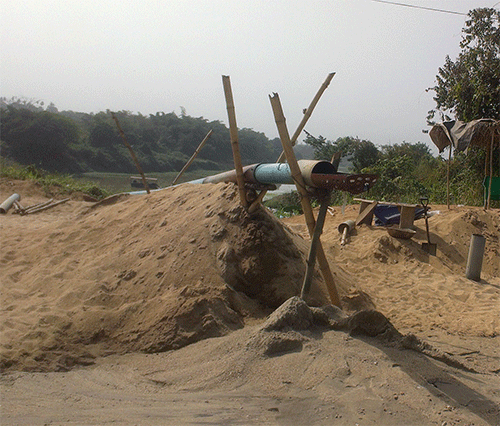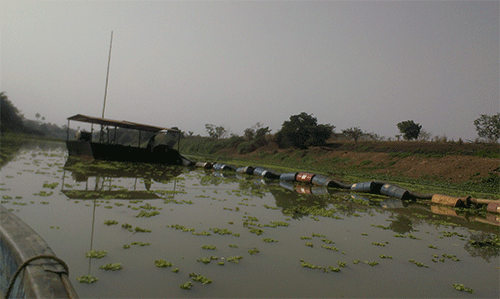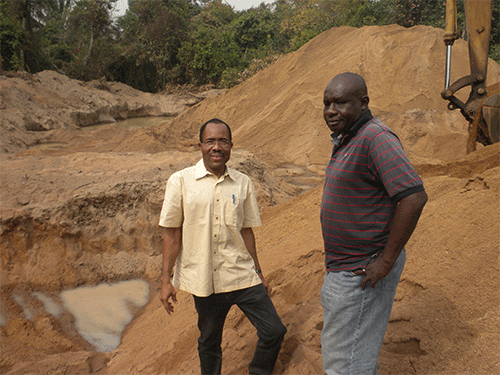
The scenic beauty of Abeokuta is complimented by a rugged sand market which is being enlarged by spillover demand from the Lagos market. The major source of the sand is the Ogun River which snakes for miles through the contours of the old city. In comparison to the neighbouring Lagos sand market, the one in Abeokuta is medium-sized. While the Lagos market produces totally for itself, the Abeokuta sand market targets heavy consumers in Lagos who are looking for a bargain on price. When DDH magazine visited in early February, the market was experiencing wide price fluctuations. A 30-ton truck of sharp sand which cost N32,000.00 in December 2015, for example, went down, first to N28,000.00, then N24,000.00 and could be haggled to N19,000.00 in one major sand stockpile site. The cost of trucking is usually extra and depends on the final destination: whether Agbara, Badagry, Ajah, Lekki Phase 1 or Lagos mainland addresses. While the 5-ton Bedford trucks are used for supplies within town, the 20-ton and 30-ton trucks handle out-of-town deliveries. Nevertheless, more than half of the sand produced by Abeokuta sand miners is used outside the ancient city. The Egbas, through time, have been sand miners because of the geological morphology of their terrain. The sharp sand from Ogun state is generally coarser than the variant that is mined in neighbouring Lagos, whether from river or land burrow pits.

The typical 8-inch dredger used on the Ogun River with improvised hollow drums for floaters.
River sand mining is mainly from the Ogun River whose seabed is dominated by large and small rock boulder. Nevertheless, sharp sand found between the rock crevices appears voluminous enough to keep the mainly mechanized sand miners from moving their dredgers frequently. It is either that the rate of siltation is very high or the sedimentation level is fast enough to cause rapid replenishment within 24 hours. The operators confirmed to DDH that their dredgers are hardly moved from burrow pit to burrow pit despite daily pumping operations. An obvious reason for this peculiarity is the predominance of large rock boulders in the river at low tide. This gives little room for swinging the dredge ladder to any wide distances. The marvel, however, is that heavy production of say, 60-40 for sand and water, can be maintained by the dredge masters daily on the same spot without swinging. Another marvel is the intensity of dredging simultaneously on the river by so many dredgers at close proximity to each other. With an average width of about 100 metres to 150 metres, in places, the Ogun River can support the work of twenty 10-inch and 12-inch dredgers clustered within a very short span at the same time. This is the situation at Obba Olokor, one of the most productive sand stockpile sites in the state.
Here, all the dredgers, which were assembled according to the simple Chinese technology, have their bundwalls hundreds of metres uphill and across the earth road that terminates at that sand market. Their run-off water pipes were also buried neatly under the same road. According to one of the operators there, Oladapo Ayodeji, the combined production of all the dredgers at the site can load five hundred 30-ton trucks with sharp sand (that is, more than 1.5 million cubic metres) at any one time. Nevertheless, the market can be considered to be seasonal because during the rainy season when the river swells, most of the dredgers now having a field day would be out of commission due to their short ladders. They would be relocated to shallower locations or laid-up to await abatement of the tide. But the operators know this too well and prepare contingency measures ahead of time. One of such measures is the mining of sharp sand from from land burrow pits which can be developed in some parts of the state. In the course of DDH’s field visits, sharp sand with higher ferruginous content and coarser grit, was found being mined at Olorunsogo village, about thirty kilometres from Abeokuta. Other places similar endowed include Papalanto flood plains, according to our escorts. The production process for this type of sharp sand varies from the mechanism of river dredging. Here, the tall trees are felled and the thick forests cleared and burnt both to create a passage to the mining site as well as a passable road for the heavy-duty haulage trucks. Then the earth overburden is scooped aside to reveal the huge volume of sharp sand deposits less than one metre from the surface.

Sharp sand being scooped from a surface burrow pit at Olorunsogo near Papalanto. R-L: Edmund Chilaka, Kunle Shodipe discussing the burrow pit.
In one site, it was estimated that the deposit could exceed one million cubic metres of sharp sand. In the place of dredgers, excavators are used to scoop the product and stockpile for sale to truckers. Unlike the conventional administration of the state’s Ministry of Commerce and Industry in Abeokuta to register river sand miners, DDH could not verify the information that only village elders and youths are solely in charge of this type of sand mining in Ogun State. The villagers parcel out the leaseholds on the land at prices between N750,000.00 and N1 million per acre per annum, depending on adjudged fertility. Perhaps the remote location of these surface mining sites can explain the absence of monitoring by the regulatory agencies. Also, the road is earthen, dusty and full of gallops while the distance is long and solitary, except for the few trucks that face you once in a long while. Thus, only the strong-willed visitor with a well-defined mission would dare the trip. When we passed the sleepy small village, however, we forded a river to get to the terrain dominated by mining sites of various sizes. In places, huge craters some of which have turned to lakes could be seen as evidence of the age-long history of mining excavations in the past. The magazine was informed that the other locales where surface mining for sharp sand takes place in the state include Mowe, Amo, Agboro and Alagada.
The other agencies which regulate sand mining in Ogun state are the National Inland Waterway Authority (NIWA) and the Federal Ministry of Mines and Steel Development (MMSD). Currently, there is a flexing of muscles between these latter agencies about their statutory mandates to collect royalties from sand miners. While MMSD lays claim to N40 per ton as due royalty, NIWA flaunts the higher rate of N100 per ton, even though the sand miners are not fooled by all the bluster. There are threats of court cases against the double taxation as some miners who spoke to the magazine decried the spate of harassments by the agencies. In the past, an uneasy pact of affordable negotiated payments to the two agencies was maintained for the sake of peace but DDH was informed of the sand miners’ possible resort to the judiciary if wiser counsel does not prevail in their ranks this time around.
